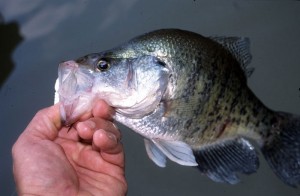This column first appeared in The Greater Ashland Beacon on Aug. 3, 2011.
By Chris Erwin
They are a lot of different kinds of fish swimming in the waters of Kentucky and most of them have anglers dedicated to catching them. The Crappie is no exception. As a matter of fact, crappie has been touted as the most sought-after fresh water fish for the dinner table.
When you hear the term “pan fish” it’s the crappie that comes to mind, from the time I was a young boy until this day, crappie is the fish you will find in my live-well and on my dinner table.
The Kentucky Department of Fish and Wildlife has done studies on crappie for good reason. Fisheries Director Benjy Kinman said, “It’s our number one fishery in the state, and drives $1.3 billion in economic output and 14,000 jobs in the state.” They are two main types of crappie – white and black – if you want to be successful in catching these fish it’s good to know the difference.

White Crappie: The white crappie has vertical bars on its side and five to six spines on its top fin. These fish tend to be in deeper water most of the year compared to the black crappie. Crappies spawn when the spring water temperature reaches 58 to68 degrees.
As a rule most anglers tend to catch more white crappie than black mostly because they misunderstand the movements of black crappie. White crappie is more tolerant of muddy water and move to deeper water brush piles quickly. The world record white crappie is 5 lbs. 3 oz. and was caught in Mississippi in 1957.
Black Crappie: The black crappie has a mottled appearance and seven to eight spines on its top fin. The black blotches or spots are not lined up into bars as they are on the white crappie. Black crappie tend to spawn in very shallow water and stay there longer than many anglers believe. The black crappie likes clear water, however, many anglers look for muddy water during spring spawning periods. The world record black crappie is reported as five pounds. but according to multiple sources around the world a 6 lb black crappie was caught in Louisiana in the 50s when records of black-and- white crappie were not kept separate. The Kentucky state record black crappie is 4Lbs. 3oz caught from Kentucky Lake.
Another good thing to know about catching crappie is that it doesn’t require expensive gear or a ton of high-dollar lures. According to the study done by the DFWF, 62 percent of crappie anglers caught their fish on tube jigs. Minnows were the second most common bait. Catching crappie doesn’t take a fancy presentation you just have to find them, and when you do, chances are good you will catch more than one.
No matter where you live in Kentucky crappie are near you, they are in farm ponds, creeks, rivers, lakes and streams. They will take your offering year around from the iced over lakes of winter, to the blistering days of summer. If you find them, you can catch them. They tend to stay in schools making multiple catches from the same location more the rule than the exception.
They are held in great regard as the best-tasting fish you can harvest with very little blood in the pearly white flesh. Crappie are mild in flavor and will complement any of your favorite fish recipes.
If you would like to learn more about how to find crappie and methods of catching them, let us know.
Till next time
Good fishing!
Chris Erwin is the founder and publisher of Kentucky Angling News, an outdoor magazine available at www.kentuckyangling.com/magazine. To reach Chris e-mail him at trimmer308@windstream.net.



Can I get a media kit
hello, Can you tell who you are and what you have done
my email is Trimmer308@gmail.com